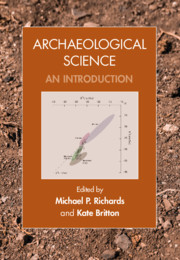Book contents
- Archaeological Science
- Archaeological Science
- Copyright page
- Contents
- Figures
- Tables
- Contributors
- Acknowledgements
- Part I Introduction
- Part II Biomolecular Archaeology
- Part III Bioarchaeology
- Part IV Environmental Archaeology
- Part V Materials Analysis
- Part VI Absolute Dating Methods
- 18 Radiocarbon Dating
- 19 Luminescence Dating
- Index
- References
19 - Luminescence Dating
from Part VI - Absolute Dating Methods
Published online by Cambridge University Press: 19 December 2019
- Archaeological Science
- Archaeological Science
- Copyright page
- Contents
- Figures
- Tables
- Contributors
- Acknowledgements
- Part I Introduction
- Part II Biomolecular Archaeology
- Part III Bioarchaeology
- Part IV Environmental Archaeology
- Part V Materials Analysis
- Part VI Absolute Dating Methods
- 18 Radiocarbon Dating
- 19 Luminescence Dating
- Index
- References
Summary
The range of chronological methods described by the term “luminescence dating” provides a rich set of tools for dating many types of events relevant to archaeological research. These include assessing the depositional age of sediments (the time elapsed since those sediment were deposited by, for example, water, wind, or human activity), and estimating the time since pottery, casting cores, or stones were last fired/heated. Following an initial suggestion by Daniels et al. (1953), luminescence dating methods were introduced into the archaeological context by Aitken et al. (1964) with the thermoluminescence (TL) dating of pottery. Since then, considerable improvements in understanding the basic underlying physical mechanisms have been translated into significant methodological breakthroughs. Notable among these was the development of optically stimulated luminescence (OSL) methods (Huntley et al. 1985) and the improved confidence in dating sedimentary material that this brought. A more recent technologically driven advance was the dating of individual sand grains (so-called single-grain dating), allowing more in-depth assessments of dating reliability and widening the applicability of OSL dating (also referred to as “optical dating”).
- Type
- Chapter
- Information
- Archaeological ScienceAn Introduction, pp. 424 - 438Publisher: Cambridge University PressPrint publication year: 2020



